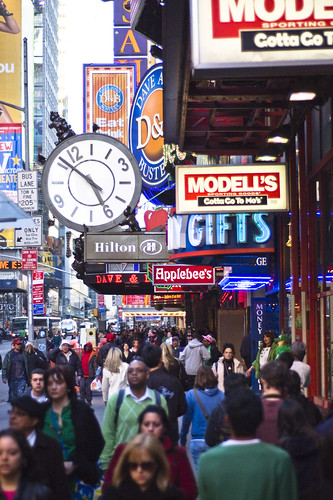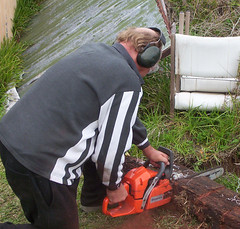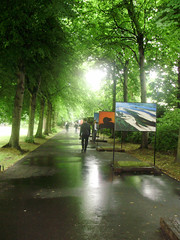How much urbanism is enough?

Posted January 13, 2011 at 1:22PM
Most of us in this business of advocating smart growth, urbanism, sustainable communities and such spend a lot of our time extolling the virtues of cities. We believe in places that are walkable, meaning they have decent pedestrian infrastructure, connected routes and places close enough to walk to. We believe homes, shops and services should be placed more closely together than is the case in recently built suburbs. We believe in density, so that environmental impacts per capita are minimized. We support public transit, basically meaning travel in groups, sometimes large ones, over the environmental and social baggage that comes with driving solo in cars. We champion the superiority of community and connection over isolation.
It’s all good, as they say. But is it?
 I’ve written before about “the environmental paradox of smart growth,” that to reduce impacts overall we must assign some of them to, and even sometimes increase them in, some places. We generally don’t talk about that in smart growth and urbanist circles, but it absolutely (and literally) comes with the territory. I still think urbanism is a choice we must make, because the benefits of density can outweigh the detriments, both for the planet and for people. But we will do a much better job of it if we identify and mitigate the potential detriments.
I’ve written before about “the environmental paradox of smart growth,” that to reduce impacts overall we must assign some of them to, and even sometimes increase them in, some places. We generally don’t talk about that in smart growth and urbanist circles, but it absolutely (and literally) comes with the territory. I still think urbanism is a choice we must make, because the benefits of density can outweigh the detriments, both for the planet and for people. But we will do a much better job of it if we identify and mitigate the potential detriments.
For example, what about my spouse, who likes to visit and enjoy cities, but likes to retreat from them even more? In her heart she prefers a nature trail or even the relative peace and quiet of a suburban back yard. I’ve mostly converted her to the smart growth paradigm, and she gets it that to save nature we must do more clustering in cities. But she’s an introvert, and not really a city person by instinct.
We compromised by settling in a relatively quiet, moderate-density city neighborhood, but even there I have come to resent the fact that my neighbors (and one aspect of small-lot, city living is that there are a lot of them) seem to think the best way to spend a nice spring weekend day is to bring out some power tools in their back yards and do whatever it is that people with power tools do, loudly. We like to sleep with the windows open, but on nice evenings the 20-somethings in the group house across the street like to hang out on their front porch until the wee hours. Who wants to sleep with earplugs?
 Mass transit isn’t always the most pleasant and nourishing experience, either. So what are we advocating, exactly?
Mass transit isn’t always the most pleasant and nourishing experience, either. So what are we advocating, exactly?
Aspects of these subjects came up in the comments on last week’s post on wellness. Two commenters pointed out (correctly) that good design, such as with courtyards, can create oases of tranquility in highly urban settings. So can pocket parks, and in fact good city parks and density need each other to maximize the benefits of both.
Scott Doyon is a principal in the town planning and development advisory firm PlaceMakers. Writing on the firm’s blog PlaceShakers and NewsMakers, Scott says that urbanism has been the right reaction to sprawl but now needs to be tempered to accommodate the human need sometimes to retreat from social interaction:
“We . . . took the suburban promise of independence and personal space to some pretty ridiculous—and dysfunctional—extremes but, in attempting to correct them, we’ve since made the mistake of confusing the need with the manner in which we satisfied it.
“Simply put, sometimes the last thing we want to do is experience another person. And that’s okay.
“Very few (perhaps none) of us are on all the time. At times, we do need to pull back, to be alone or with intimate gatherings of carefully chosen people.
“Community, for all its benefits, is a tiring endeavor. But that’s a hard thing to consider when the larger conversation . . . is focused on all the measurable ways urbanism can help us solve our problems—from the environmental to the economic to the social.”
Scott closes by reminding us that we need to design and build better private space. Not necessarily more of it, but better. Food for thought.
Wendy Waters, who researches and analyzes urban economic trends and writes the blog All About Cities, seems to agree. Comparing locations with different Walk Scores, she suggests that the urbanist Holy Grail of a perfect 100 score may not be for everyone. She likes her own neighborhood (Walk Score 98), but concedes that a high volume of traffic and noise and a lack of privacy can all be aggravating. A still urban but less intense setting might be better :
“A couple decades ago, few people wanted walkability–they wanted quiet, or the perceived security of auto-centered life.
Today, many want the opposite. But maybe we’ve gone too far in thinking everybody should have everything close by? Perhaps even more people would embrace an urban life with an 85 walkscore?”
The comments on the post add interesting perspective to the discussion, most of them also using Walk Score while discussing the tradeoffs that come with urban living. One commenter said that she would gladly give up “ten, twenty, even thirty points” in Walk Score to get away from the noise. Responding to the comments, Waters writes that “in many cities and neighborhoods there are almost-linear balancing opportunities between extreme-walkability-with-noise vs. increasingly quieter or more private living, but a need to walk a few extra blocks.”
As with the essay that Lee and I wrote on design, I think this may be an issue we haven’t completely figured out yet. I suppose one too-easy answer is that there never has been and shouldn’t be a one-size-fits-all approach to smart growth and urbanism. We can and should provide a variety of environments that offer a range of living choices while staying well within the framework of sustainability.  People who value community over quiet should be able to choose that, and vice versa. New urbanism offers the transect as a way of providing different levels of appropriate urban intensity in different parts of a region.
People who value community over quiet should be able to choose that, and vice versa. New urbanism offers the transect as a way of providing different levels of appropriate urban intensity in different parts of a region.
But the availability of choices within urban settings can be tough to realize on the ground, where real-world development occurs in limited-scale, scattered fashion, one parcel here, another there, with developers eager to maximize returns on investment. In the DC area, I’m not seeing much moderate density (say, 10 to 20 homes per acre) being proposed anywhere, except in the far outer ‘burbs where it won’t do much good environmentally, even if builders can find buyers for it. For infill and transit-adjacent projects, I’m seeing plenty of proposed and recently built intensity, but hardly ever a park or the kind of tranquil, publicly accessible courtyard that commenters were describing on this blog last week. And even the best new development can’t do much if anything to redress problems that have been created by the intensity of existing urbanism.
Is more attention to moderate density, in more places, part of the answer? Maybe, and so is better design. But perhaps there are other answers, too. That we must have more urbanism isn’t up for debate, as far as I’m concerned. So let’s keep working on getting it right, and getting it better.
Move your cursor over the images for credit information.